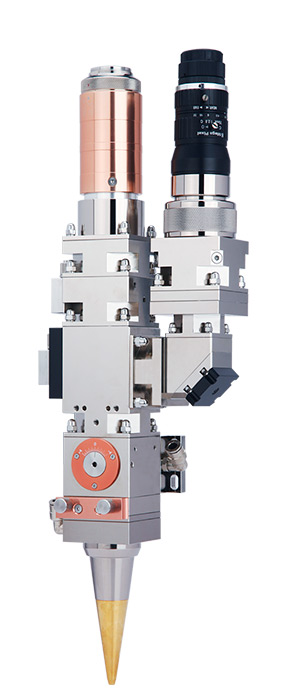What is the difference between high-speed laser welding head cladding and conventional laser welding head cladding
In the past two years, the high-speed laser welding head cladding technology has been highly valued by China's laser head industry and metal surface treatment industry. Shenzhen Wanshunxing laser welding head as a representative enterprise, the high-speed laser welding head cladding technology has developed rapidly in China. According to the development status of the domestic laser welding head industry, the company has been independently developing for 6 years, and has successively introduced a series of high-speed cladding laser heads and 2000W, 4000W, 6000W and other complete sets of equipment. The company has completely independent intellectual property rights and provides strong equipment and technical support for the development of China's high-speed laser welding head cladding industry.
The reason why high-speed laser head cladding has attracted widespread attention is that, compared with traditional laser head cladding, high-speed laser welding head cladding has the advantages of high processing efficiency, high processing accuracy, low follow-up processing costs, small heat input to the workpiece, and reduced processes. . The detailed comparison of workpiece deformation, etc. is as follows:
Compared with traditional laser welding head cladding, high-speed laser welding head cladding has the following advantages:
(1) The linear speed can reach 100 m/min, which greatly improves the cladding efficiency. The alloy steel substrate with a diameter of 70 is coated with martensitic stainless steel material, the coating thickness is 0.5mm, the lap joint is 70%, the coating efficiency can reach 1.2㎡/h, and the overall processing efficiency is 3-4 times the traditional coating time. time.
(2) The cladding is flat and can be directly ground and polished without turning, which greatly saves material and processing costs.
(3) In special cases, it can be thin coating cladding (0.2mm-0.3mm) or medium thick coating cladding (0.3-1.5), thin and thick, or multi-layer cladding.
(4) High-speed cladding has small heat input to the workpiece and small thermal deformation of the workpiece, which can be used to process thin-walled parts and small parts.
(5) The dilution rate can be controlled at < 3%.
(6) The laser welding head has high power density and can cover high melting point powder materials.
(7) Surface strengthening of non-ferrous metal materials such as copper, aluminum, and titanium can be achieved (see the detailed analysis below).
(8) High-speed cladding has broken many application fields of traditional cladding, is widely used, and is the only feasible method to replace electroplating at present.

2. The disadvantages of high-speed laser head cladding intersecting with traditional laser welding head cladding are:
(1) At present, the powder utilization rate of high-speed cladding is about 70%, which is slightly lower than that of traditional laser head cladding, which needs to be further improved by technical means.
(2) High-speed laser head cladding generally uses 20-53um fine spherical powder to pursue higher surface quality, thereby saving materials and reducing processing costs, while traditional laser head cladding generally uses 50-150um coarse powder. The cost of fine flour is slightly higher than that of coarse flour.
(3) High-speed laser welding head cladding is a new technology that is slightly more complicated than traditional cladding.
3. The common points between high-speed laser welding head cladding and traditional laser welding head cladding are:
(1) Cladding materials are common. Traditional laser welding head cladding can be used for cladding materials, while high-speed laser welding head cladding can be used for cladding; some materials that cannot be melted by traditional laser welding head cladding, such as high melting point materials, can be welded by high-speed laser welding. Head cladding melts.
(2) All of these are metallurgical combinations. However, the coating effect of the high-speed coating is similar to thermal spraying, and the surface is flat. Conventional cladding fluctuates greatly.
(3) General process route. The key point of the adjustment of the cladding process of the traditional laser welding head is also the key to the adjustment of the cladding process of the high-speed laser head.
(4) The application fields are consistent. In other words, high-speed laser head cladding can be applied to fields where traditional laser welding head cladding can be applied, and high-speed laser head cladding can also be applied to fields where traditional laser head cladding cannot be applied. Generally speaking, traditional laser welding head cladding can complete high-speed laser head cladding, and can also perform high-speed laser head cladding that cannot be accomplished by traditional laser welding head cladding.
4. Why is high-speed laser head cladding applied to non-ferrous metals such as copper and aluminum?
Surface strengthening of copper and aluminum has always been an urgent need in the industry, but the process is very difficult. At present, spraying and electroplating processes can be used under the condition of non-metallurgical combination. In the case of metallurgical bonding, YAG laser cladding can currently be used for traditional laser welding head cladding, but the YAG process is inefficient. Other conventional excitations, such as carbon dioxide, semiconductors, semiconductor fiber coupling, etc.
Some schools and businesses have done extensive research on cladding routes, but the end result is not ideal. The main reason is that copper and aluminum are difficult to coat due to rapid thermal conduction, and the matrix does not easily form a molten pool.
China, the United States and the United States apply high-speed laser head cladding technology to the surface treatment of non-ferrous metals. From the preliminary test results, high-speed laser head cladding can completely solve the industry's problems. The power density of high-speed laser head cladding is 5-10 times higher than that of traditional laser welding head cladding. Part of the light directly acts on the substrate, thereby forming a molten pool on the copper and aluminum substrate. This is the main reason why high-speed laser head cladding can be achieved. Copper aluminum cladding.









